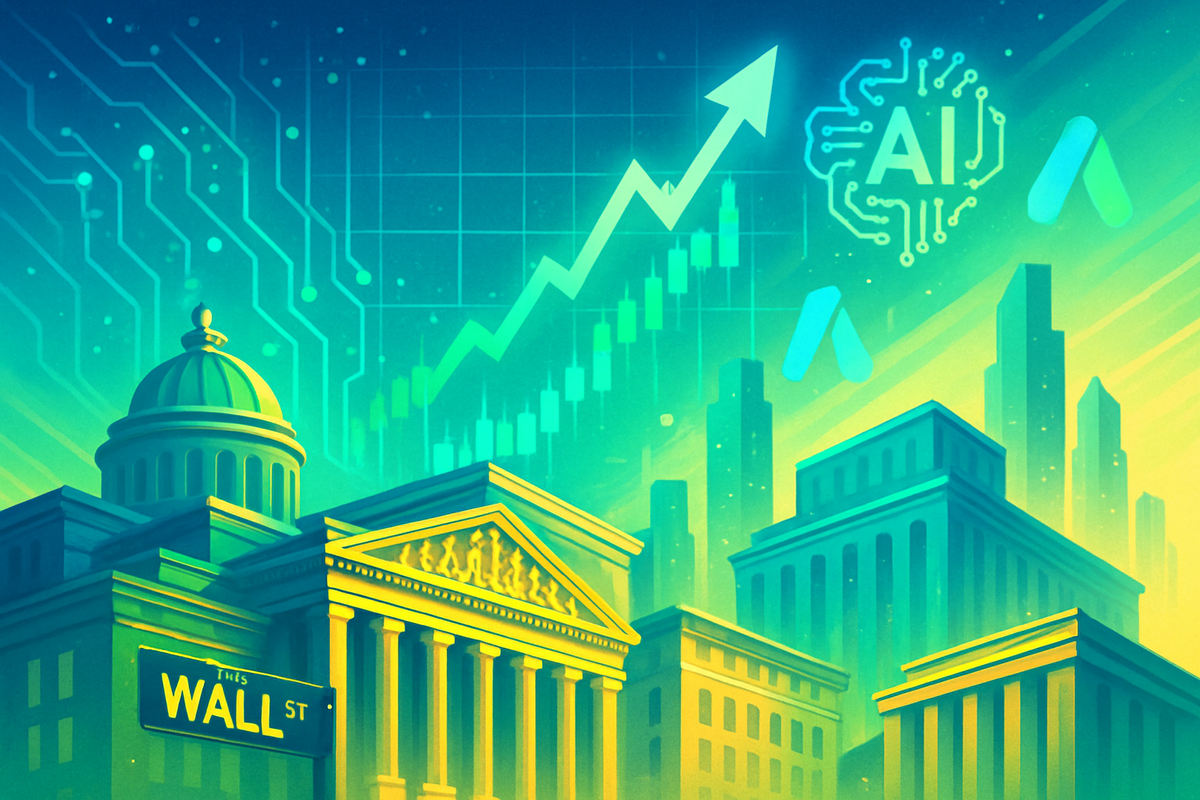
Wall Street is experiencing a robust advance, with technology and growth stocks spearheading significant gains across global equity markets. This surge, primarily fueled by an insatiable investor appetite for artificial intelligence (AI) innovation and strong corporate earnings from the tech sector, has seen major indices like the S&P 500 and Nasdaq Composite reach impressive new highs. The immediate implication is a market increasingly concentrated around a select group of powerful tech companies, raising both excitement about future growth and concerns about potential overvaluation and systemic risk.
This rally underscores a pivotal shift in market leadership, where companies at the forefront of technological advancement are disproportionately driving overall market performance. While the broader market has seen positive movement, the exceptional performance of tech and growth sectors highlights a clear investor preference for disruptive innovation and companies poised for long-term expansion in the burgeoning digital economy.
The AI-Driven Ascent: A Detailed Look at Market Dynamics
The current Wall Street advance is a story deeply intertwined with the relentless march of technological innovation, particularly in artificial intelligence. Throughout 2025, the market has witnessed a sustained upward trajectory, with the S&P 500 surging 14% year-to-date, the Nasdaq Composite climbing 17%, and the Dow Jones Industrial Average gaining 6%. This robust performance marks one of the strongest bull phases seen since 2021, with the S&P 500 consistently challenging and often surpassing its all-time highs.
The timeline leading up to this moment shows a consistent build-up of investor confidence in the tech sector. Following a broadening of the rally in the latter half of 2024, 2025 has seen an acceleration, largely due to a confluence of factors: persistent optimism surrounding AI's transformative potential, prospects of Federal Reserve rate cuts, and surprisingly strong corporate earnings reports from major technology firms. Key players, often dubbed the "Magnificent Seven," including Apple (NASDAQ: AAPL), Nvidia (NASDAQ: NVDA), Microsoft (NASDAQ: MSFT), Amazon (NASDAQ: AMZN), Alphabet (NASDAQ: GOOGL), and Meta Platforms (NASDAQ: META), have been central to this narrative. These companies, recognized for their global market dominance, robust balance sheets, and leadership in AI, have been central to this narrative. These companies, recognized for their global market dominance, robust balance sheets, and leadership in AI, have seen their stock prices soar, pulling the broader market along with them.
Initial market reactions have been overwhelmingly positive, yet tinged with caution. While analysts celebrate the innovation and growth, there are growing concerns about market concentration. The top 10 U.S. companies, eight of which are in the technology sector, now account for nearly a quarter of the global equity market – a level of concentration not seen in decades. This has led to warnings from institutions like the Bank of England and the IMF about "toppy" valuations, particularly within the tech sector, and the potential for a disconnect between these high valuations and a weaker global economic outlook. Despite these warnings, investor exuberance, especially among retail investors who have adopted a "buy-the-dip" mentality, continues to fuel the rally.
Winners and Losers: The Shifting Sands of Market Leadership
The current tech-led Wall Street advance has created a distinct cleavage in the market, clearly delineating potential winners and losers. At the forefront of the winning cohort are, unequivocally, technology and growth stocks, particularly those deeply embedded in the artificial intelligence ecosystem. Companies like Nvidia (NASDAQ: NVDA), a leader in AI chip design, have seen astronomical gains as demand for their processors explodes. Similarly, software giants such as Microsoft (NASDAQ: MSFT) and cloud computing powerhouses like Amazon (NASDAQ: AMZN) and Alphabet (NASDAQ: GOOGL) are benefiting immensely from increased enterprise spending on AI infrastructure and services. These companies are poised to win due to their superior earnings growth, strong competitive advantages, and the transformative potential of their AI investments, which promise to unlock new revenue streams and enhance productivity. Their robust balance sheets allow them to continually invest in research and development, further cementing their market positions.
Conversely, traditional value stocks and companies in more cyclical or mature industries may find themselves lagging. While the overall market has advanced, the performance gap between growth and value has widened, with the Russell 1000 Growth Index significantly outperforming its value counterpart. Companies with slower growth prospects, or those heavily reliant on traditional economic cycles, may struggle to attract the same level of investor capital and enthusiasm. While not necessarily "losing" in absolute terms, their relative underperformance means they are missing out on the outsized gains seen in the tech sector. This dynamic can lead to a misallocation of capital and increased risk for portfolios heavily weighted towards sectors not participating in the tech-driven rally.
Furthermore, within the tech sector itself, smaller or less innovative companies might struggle to keep pace with the "Magnificent Seven." The market's focus on a few dominant players means that capital often flows to these established leaders, making it harder for nascent tech firms to gain traction or secure significant investment, unless they possess a truly disruptive AI solution. This concentration of wealth and power within a handful of companies could stifle broader innovation if smaller players are starved of capital. The implication for these companies is a potential struggle for market relevance and investor attention in an environment dominated by tech behemoths.
Wider Significance: A New Era of Market Dynamics
This tech-led Wall Street advance signifies more than just a temporary market trend; it points to a potentially new era of market dynamics driven by technological paradigm shifts. The intense focus on AI is not merely speculative but reflects a genuine belief in its capacity to revolutionize industries, enhance productivity, and create unprecedented value. This event fits squarely into the broader industry trend of digitalization and automation, accelerating a shift towards an information economy where data and intellectual property are paramount. The sustained outperformance of tech and growth stocks underscores a long-term structural change, where innovation-driven companies are increasingly seen as the primary engines of economic growth.
The ripple effects of this concentration are profound. For competitors, especially those in traditional sectors, the challenge is immense. They face pressure to adopt AI technologies rapidly to remain competitive, often requiring significant capital expenditure and a complete overhaul of business models. This can lead to increased M&A activity as traditional companies seek to acquire AI capabilities, or conversely, to market consolidation where smaller, less adaptable firms are squeezed out. For partners, particularly those in the supply chain for the "Magnificent Seven," there are opportunities for growth, but also the risk of becoming overly reliant on a few dominant clients. The sheer scale and market power of these tech giants can dictate terms, affecting pricing and operational strategies for their partners.
Regulatory and policy implications are also beginning to emerge. Governments worldwide are grappling with how to regulate the burgeoning AI industry, addressing concerns around data privacy, algorithmic bias, market dominance, and potential job displacement. The increasing market concentration could also draw antitrust scrutiny, as regulators examine whether these tech behemoths are stifling competition. Historically, periods of intense technological innovation and market concentration, such as the dot-com boom of the late 1990s, have often been followed by regulatory interventions or significant market corrections. While the current rally is seen by some as fundamentally driven by earnings, the parallels to past speculative bubbles, in terms of investor exuberance and valuation concerns, are not lost on market observers. The key difference this time, proponents argue, is the tangibility of AI's impact and the robust balance sheets of the leading companies.
What Comes Next: Navigating the Future Landscape
Looking ahead, the trajectory of this tech-led market advance presents a spectrum of possibilities, both short-term and long-term. In the short term, the market will likely continue to be highly sensitive to earnings reports from the major tech players, Federal Reserve policy signals regarding interest rates, and any developments in AI regulation. Continued strong earnings and optimistic guidance from tech giants could sustain the rally, potentially leading to further market highs. However, any significant disappointment in earnings, a hawkish shift from the Fed, or increased regulatory pressure could trigger a notable correction, given the stretched valuations and concentrated nature of the market. Investors should brace for potential volatility as the market digests new information and sentiment shifts.
In the long term, the implications are even more profound. The widespread adoption of AI is expected to drive significant productivity gains across various industries, creating new market opportunities in areas like advanced robotics, personalized medicine, and smart infrastructure. Companies that strategically pivot to integrate AI into their core operations and product offerings will be best positioned for sustained growth. This requires not just technological adoption but also organizational restructuring and talent development. Market opportunities will emerge for companies providing AI infrastructure, software, and specialized services, as well as those leveraging AI to disrupt traditional sectors. Conversely, businesses that fail to adapt risk becoming obsolete, facing challenges in competing with more agile, AI-powered rivals.
Potential scenarios range from a "soft landing" where the rally gradually broadens to include other sectors, leading to a more diversified and sustainable bull market, to a "hard landing" scenario characterized by a sharp correction if valuations become unsustainable or a major economic shock occurs. Another possibility is a continued "two-tiered market" where tech and growth stocks maintain their dominance, leaving other sectors to underperform. Investors and businesses alike must remain agile, continuously re-evaluating their strategies and portfolios. Diversification beyond the concentrated tech sector, exploring international markets, and investing in real assets could become increasingly important strategies to mitigate risk and capture broader opportunities in an evolving economic landscape.
Comprehensive Wrap-Up: Assessing the Enduring Impact
The current Wall Street advance, unequivocally led by the technology and growth sectors, marks a significant period in financial markets, driven primarily by the transformative promise of artificial intelligence. The key takeaway is the unprecedented concentration of market gains within a handful of tech behemoths, whose robust earnings and innovative pipelines have fueled a powerful rally. While this surge reflects genuine technological progress and strong corporate fundamentals in the tech space, it simultaneously raises critical questions about market breadth, valuation sustainability, and systemic risk. The "Magnificent Seven" have not only dominated returns but have also reshaped investor expectations, prioritizing future growth and technological disruption over traditional value metrics.
Moving forward, the market is poised for continued evolution, heavily influenced by the pace of AI development and its integration across industries. While the immediate future may see ongoing volatility, the long-term impact of AI is expected to be a significant driver of economic growth and corporate profitability. However, the sustainability of the current rally hinges on several factors: the ability of tech companies to continue delivering exceptional earnings, the Federal Reserve's monetary policy decisions, and the regulatory landscape for AI. Any significant shift in these areas could trigger a re-evaluation of current market valuations.
For investors, the coming months will demand vigilance and strategic thinking. It is crucial to monitor not only the performance of the leading tech stocks but also signs of broadening market participation. While the allure of high-growth tech remains strong, a balanced approach that considers diversification across sectors, geographies, and asset classes will be paramount. Investors should watch for early indicators of regulatory action on big tech, shifts in consumer and enterprise AI adoption rates, and the performance of smaller, innovative AI companies that could emerge as future leaders. Understanding the interplay between technological advancement, economic policy, and market sentiment will be key to navigating this dynamic and potentially transformative period in financial history.
This content is intended for informational purposes only and is not financial advice







